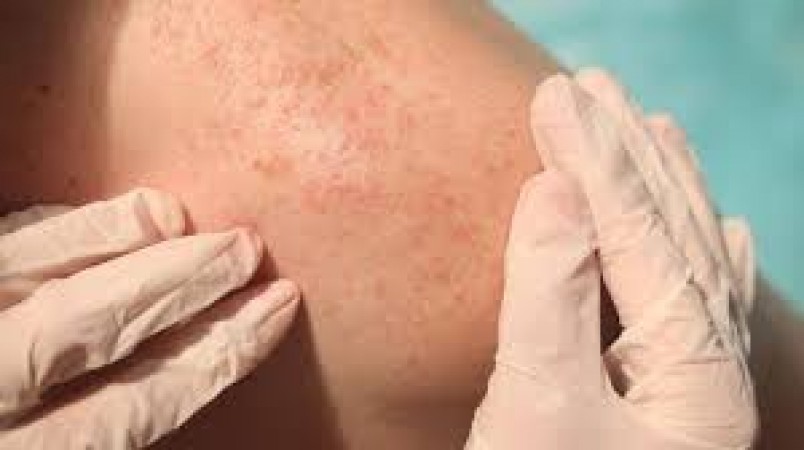
Heat rashes, also known as prickly heat or miliaria, occur when sweat gets trapped in the pores of your skin. This blockage causes red, itchy, and sometimes painful bumps, often appearing in areas like the neck, back, chest, and folds of the skin.
There are several types of heat rashes:
High temperatures and humidity are primary culprits. When it's hot, sweat production increases, which can lead to blocked sweat glands.
Wearing tight or non-breathable clothing can trap sweat, exacerbating the issue.
Intense exercise or physical labor increases sweating, which can contribute to the development of heat rashes.
Spending too much time in hot environments, such as a kitchen or a crowded room, can trigger heat rashes.
In some cases, heat rashes can lead to:
Keep your skin cool and dry to prevent sweat buildup. Use fans or air conditioning, and take cool showers frequently.
Opt for loose, breathable fabrics like cotton to allow your skin to breathe.
Heavy skincare products can block pores. Choose lightweight, non-comedogenic products instead.
When outdoors, take frequent breaks in the shade or indoors to cool down.
Aloe Vera Gel: Apply aloe vera gel to soothe the skin and reduce inflammation. It's cooling and has antibacterial properties.
Oatmeal Baths: Adding colloidal oatmeal to your bath can soothe itching and reduce inflammation.
Cold Compresses: Applying a cold compress can help reduce itching and swelling.
Baking Soda Paste: Mix baking soda with water to create a paste and apply it to the rash. It helps to dry out the rash and relieve itching.
Cornstarch: Dust affected areas with cornstarch to keep them dry and reduce friction.
Hydrocortisone Cream: This anti-inflammatory cream can help reduce itching and swelling.
Calamine Lotion: Calamine soothes the skin and provides relief from itching.
Antihistamines: Oral antihistamines like Benadryl can help reduce itching and discomfort.
If the rash doesn't improve within a few days of home treatment, consult a doctor.
Look out for signs of infection, such as increased redness, swelling, pain, or pus.
If you experience severe symptoms like fever or chills, seek medical attention immediately.
Drink Plenty of Water: Staying hydrated helps regulate your body temperature and reduces sweating.
Talcum Powder: Applying talcum powder to prone areas can help keep the skin dry.
Breathable Fabrics: Wearing fabrics like cotton can help your skin breathe and reduce sweat buildup.
Limit Sun Exposure: Stay out of the sun during peak hours to avoid overheating.
Cool Environment: Use fans, air conditioning, and dehumidifiers to keep your living space cool.
Chamomile: Chamomile tea compresses can soothe irritated skin and reduce redness.
Lavender Oil: Diluted lavender oil has anti-inflammatory properties and can soothe the skin.
Neem: Neem leaves or neem oil have antibacterial and anti-inflammatory properties beneficial for heat rashes.
Water-Rich Foods: Eat cucumbers, watermelon, and other water-rich foods to stay hydrated.
Cooling Foods: Include cooling foods like yogurt and mint in your diet.
Avoid Spicy Foods: Spicy foods can increase body heat and sweating, which might worsen heat rashes.
Anyone can get heat rashes, though they are more common in children due to their developing sweat glands.
Heat rashes are not contagious. They result from blocked sweat glands and cannot be passed from person to person.
Scratching can actually worsen the rash and increase the risk of infection. It's best to soothe the itch with appropriate treatments.
Regular Hygiene: Regular showers and proper hygiene can help prevent heat rashes.
Moisturizing: Use lightweight, non-comedogenic moisturizers to keep your skin hydrated without blocking pores.
Avoiding Triggers: Identifying and avoiding triggers like certain fabrics or activities can help manage and prevent heat rashes.
Balanced Diet: A balanced diet rich in vitamins and minerals supports overall skin health.
Hydration: Drinking enough water daily is crucial for maintaining healthy skin and preventing rashes.
Keep an eye on your skin, especially during hot weather. Early intervention can prevent heat rashes from worsening.
If in doubt, always consult a healthcare professional for advice tailored to your specific situation.
With the right precautions, you can enjoy summer activities without the discomfort of heat rashes.
Such a magical forest of India, which glows at night!
These are the 3 most expensive bikes sold in India, the price is so much that you will buy Audi-BMW
Lemon Rice: Learn to make South Indian dish 'Lemon Rice' in easy steps